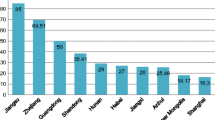Abstract
The article reviews a state policy of China, due to which the country has managed to develop the world’s largest sector of renewable energy sources (RES). Basic aspects of the formation and development of a comprehensive system of state support for the sector, i.e., the creation of scientific and technological advancement, stimulation of renewable energy equipment manufacturing, and support for RES electricity generation, are studied. Key programs implemented in specific stages are analyzed. Considerable attention is paid to the role and characteristics of foreign technology transfers. The dynamics of China’s RES sector and the results of its rapid growth with the active participation of the state are researched. On the basis of the analysis, it is concluded that, in general, China’s experience in development of RES is successful. Using the example of China, it is safe to say that, in the presence of a balanced state policy, a country is able to create in a decade a strong renewable energy equipment industry and to become a leader in the area of RES electricity generation. Specific features and main problems of the Russian RES sector are considered. On the basis of China’s experience, recommendations for improving the state policy in RES are made for Russia. According to the authors, first of all, a sharp increase in state support for scientific research and development (R&D), pilot and demonstration projects, recognition of RES as a part of the fuel and energy sector at all tiers of authority, guarantees of state support for RES in the long run, ensuring access to long-term funds, and the creation of state programs supporting households participation in the distributed power generation are needed.
Similar content being viewed by others
References
Clean Energy Investment by the Numbers — End of Year 2015 (Bloomberg New Energy Finance, 2015). https://www.bnef.com/dataview/clean-energy-investment/index. html.
Q. Wang, “Effective policies for renewable energy — The example of China’s wind power — lessons for China’s photovoltaic power,” Renewable Sustainable Energy Rev. 14, 702–712 (2010).
C. Huang, J. Su, X. Zhao, J. Sui, P. Ru, H. Zhang, and X. Wang, “Government funded renewable energy innovation in China,” Energy Policy 51, 121–127 (2012).
Z.-Y. Zhao, Y.-L. Chen, and R.-D. Chang, “How to stimulate renewable energy power generation effectively? — China’s incentive approaches and lessons,” Renewable Energy 92, 147–156 (2016).
B. Müller, D. Robinson, Z. Xiliang, C. Ellermann, H. Molin, D. Torney, and Z. Jian, Addressing Large Developing Country Emissions (The Oxford Institute for Energy Studies, Oxford, 2010).
International Support for Domestic Climate Policies in Developing Countries, Ed. by K. Neuhoff (Earthscan, London, 2009).
J. I. Lewis, “Building a national wind turbine industry: Experiences from China, India and South Korea,” Int. J. Technol. Globalisation 5, 281–305 (2011).
J. Yuan, C. Na, Y. Xu, and C. Zhao, “Wind turbine manufacturing in China: A review,” Renewable Sustainable Energy Rev. 51, 1235–1244 (2015).
R. Vos and D. Alarcon, Technology and Innovation for Sustainable Development (Bloomsbury, Norwich, 2015).
N. Vig and M. Kraft, Environmental Policy: New Directions for the Twenty-First Century (CQ, Washington, DC, 2012).
B. Carbaugh and M. St. Brown, “Industrial policy and renewable energy: trade conflicts,” J. Int. Global Econ. Stud. 5 (1), 1–16 (2012).
N. Robins, R. Clover, and C. Singh, A Climate for Recovery: The Colour of Stimulus Goes Green (HSBC, London, 2009).
C. García, “Policies and institutions for grid-connected renewable energy. “Best practice” and the case of China,” Governance: Int. J. Policy, Adm., Inst. 26, 119–146 (2013).
S. Zhang, P. Andrews-Speed, X. Zhao, and Y. He, “Interactions between renewable energy policy and renewable energy industrial policy: A critical analysis of China’s policy approach to renewable energies,” Energy Policy 62, 342–353 (2013).
Top 10 Energy Innovators in 100 Energy Priorities (KIC InnoEnergy, 2015).
V. Sidorovich, Global Energy Revolution: How Renewable Energy Sources Shall Change Our World (Al’pina, Moscow, 2015) [in Russian].
BP Statistical Review of World Energy (BP, 2016).
Z. Wu, H. Sun, and Y. Du, “A large amount of idle capacity under rapid expansion: Policy analysis on the dilemma of wind power utilization in China,” Renewable Sustainable Energy Rev. 32, 271–277 (2014).
“Electric generator capacity factors vary widely across the world” (U. S. Energy Inf. Adm., 2015).
R. Campbell, China and the United States — A comparison of Green Energy Programs and Policies (Congr. Res. Serv., Washington, DC, 2014).
Author information
Authors and Affiliations
Corresponding author
Additional information
Original Russian Text © T.A. Lanshina, A.V. Kulakov, 2017, published in Teploenergetika.
Rights and permissions
About this article
Cite this article
Lanshina, T.A., Kulakov, A.V. Development of renewable energy in China: Studying the experience and making recommendations for Russia. Therm. Eng. 64, 526–533 (2017). https://doi.org/10.1134/S0040601517070035
Received:
Accepted:
Published:
Issue Date:
DOI: https://doi.org/10.1134/S0040601517070035




